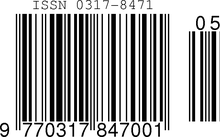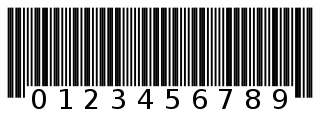
The EAN-2 is a supplement to the EAN-13 and UPC-A barcodes. It is often used on magazines and periodicals to indicate an issue number.

The EAN-2 is a supplement to the EAN-13 and UPC-A barcodes. It is often used on magazines and periodicals to indicate an issue number.
The encoding of EAN-2 characters is very similar to that of the other European Article Numbers. The only difference is that the digits are separated by 01. The EAN-2 always begins with "01011". Also, the R-Code is not used.
| Digit | L-code | G-code |
|---|---|---|
| 0 | 0001101 | 0100111 |
| 1 | 0011001 | 0110011 |
| 2 | 0010011 | 0011011 |
| 3 | 0111101 | 0100001 |
| 4 | 0100011 | 0011101 |
| 5 | 0110001 | 0111001 |
| 6 | 0101111 | 0000101 |
| 7 | 0111011 | 0010001 |
| 8 | 0110111 | 0001001 |
| 9 | 0001011 | 0010111 |
The structure of the barcode is based on the value of the two digit to be encoded. The two digits treated as a single two-digit number is reduced modulo 4 and used to find the parity pattern to be used. The parity pattern repeats every 4 values.
| Data to encode | Parity pattern | |
|---|---|---|
| 00 | LL | Encode as 0 from L table followed by 0 from L table |
| 01 | LG | Encode as 0 from L table followed by 1 from G table |
| 02 | GL | Encode as 0 from G table followed by 2 from L table |
| 03 | GG | Encode as 0 from G table followed by 3 from G table |
| 04 | LL | Encode as 0 from L table followed by 4 from L table |
| 05 | LG | Encode as 0 from L table followed by 5 from G table |
| 06 | GL | Encode as 0 from G table followed by 6 from L table |
| 07 | GG | Encode as 0 from G table followed by 7 from G table |
| ... | ... | |
| 98 | GL | Encode as 9 from G table followed by 8 from L table |
| 99 | GG | Encode as 9 from G table followed by 9 from G table |
| Start | 5 (L) | Separator | 3 (G) |
|---|---|---|---|
| 01011 | 0110001 | 01 | 0100001 |

The International Standard Book Number (ISBN) is a numeric commercial book identifier which is intended to be unique. Publishers purchase ISBNs from an affiliate of the International ISBN Agency.

In telecommunication, a two-out-of-five code is an m of n code that provides exactly ten possible combinations, and thus is popular for representing decimal digits using five bits. There are ways to assign weights to each bit such that the set bits sum to the desired value, with an exception for zero.
The Universal Product Code (UPC) is a barcode symbology that is widely used in the United States, Canada, United Kingdom, Australia, New Zealand, in Europe and other countries for tracking trade items in stores.

A barcode is an optical, machine-readable representation of data; the data usually describes something about the object that carries the barcode. Traditional barcodes systematically represent data by varying the widths and spacings of parallel lines, and may be referred to as linear or one-dimensional (1D). Later, two-dimensional (2D) variants were developed, using rectangles, dots, hexagons and other geometric patterns, called matrix codes or 2D barcodes, although they do not use bars as such. Initially, barcodes were only scanned by special optical scanners called barcode readers. Later application software became available for devices that could read images, such as smartphones with cameras.

Code 39 is a variable length, discrete barcode symbology.
POSTNET is a barcode symbology used by the United States Postal Service to assist in directing mail. The ZIP Code or ZIP+4 code is encoded in half- and full-height bars. Most often, the delivery point is added, usually being the last two digits of the address or PO box number.
A check digit is a form of redundancy check used for error detection on identification numbers, such as bank account numbers, which are used in an application where they will at least sometimes be input manually. It is analogous to a binary parity bit used to check for errors in computer-generated data. It consists of one or more digits computed by an algorithm from the other digits in the sequence input.

PDF417 is a stacked linear barcode symbol format used in a variety of applications; primarily transport, identification cards, and inventory management. PDF stands for Portable Data File. The 417 signifies that each pattern in the code consists of bars and spaces, and that each pattern is 17 units long. The PDF417 symbology was invented by Dr. Ynjiun P. Wang at Symbol Technologies in 1991. It is ISO standard 15438.

Aztec Code is a type of 2D barcode invented by Andrew Longacre, Jr. and Robert Hussey in 1995. The code was published by AIM, Inc. in 1997. Although the Aztec code was patented, that patent was officially made public domain. The aztec code is also published as ISO/IEC 24778:2008 standard. Named after the resemblance of the central finder pattern to an Aztec pyramid, Aztec code has the potential to use less space than other matrix barcodes because it does not require a surrounding blank "quiet zone".

Code 128 is a high-density linear barcode symbology defined in ISO/IEC 15417:2007. It is used for alphanumeric or numeric-only barcodes. It can encode all 128 characters of ASCII and, by use of an extension symbol (FNC4), the Latin-1 characters defined in ISO/IEC 8859-1.

Interleaved 2 of 5 (ITF) is a continuous two-width barcode symbology encoding digits. It is used commercially on 135 film, for ITF-14 barcodes, and on cartons of some products, while the products inside are labeled with UPC or EAN.
Global Trade Item Number (GTIN) is an identifier for trade items, developed by GS1. Such identifiers are used to look up product information in a database which may belong to a retailer, manufacturer, collector, researcher, or other entity. The uniqueness and universality of the identifier is useful in establishing which product in one database corresponds to which product in another database, especially across organizational boundaries.

The International Article Number is a standard describing a barcode symbology and numbering system used in global trade to identify a specific retail product type, in a specific packaging configuration, from a specific manufacturer. The standard has been subsumed in the Global Trade Item Number standard from the GS1 organization; the same numbers can be referred to as GTINs and can be encoded in other barcode symbologies defined by GS1. EAN barcodes are used worldwide for lookup at retail point of sale, but can also be used as numbers for other purposes such as wholesale ordering or accounting.

GS1-128 is an application standard of the GS1 implementation using the Code 128 barcode specification. The former correct name was UCC/EAN-128. Other no longer used names have included UCC-128 and EAN-128. The GS1-128 standard was introduced in 1989 and uses a series of Application Identifiers to include additional data such as best before dates, batch numbers, quantities, weights and many other attributes needed by the user.
Codabar is a linear barcode symbology developed in 1972 by Pitney Bowes Corp. It and its variants are also known as Codeabar, Ames Code, NW-7, Monarch, Code 2 of 7, Rationalized Codabar, ANSI/AIM BC3-1995 or USD-4.

MSI is a barcode symbology developed by the MSI Data Corporation, based on the original Plessey Code symbology. It is a continuous symbology that is not self-checking. MSI is used primarily for inventory control, marking storage containers and shelves in warehouse environments.

An EAN-8 is an EAN/UPC symbology barcode and is derived from the longer International Article Number (EAN-13) code. It was introduced for use on small packages where an EAN-13 barcode would be too large; for example on cigarettes, pencils, and chewing gum packets. It is encoded identically to the 12 digits of the UPC-A barcode, except that it has 4 digits in each of the left and right halves.

The Intelligent Mail Barcode is a 65-bar barcode for use on mail in the United States. The term "Intelligent Mail" refers to services offered by the United States Postal Service for domestic mail delivery. The IM barcode is intended to provide greater information and functionality than its predecessors POSTNET and PLANET. An Intelligent Mail barcode has also been referred to as a One Code Solution and a 4-State Customer Barcode, abbreviated 4CB, 4-CB or USPS4CB. The complete specification can be found in USPS Document USPS-B-3200. It effectively incorporates the routing ZIP code and tracking information included in previously used postal barcode standards.

The EAN-5 is a 5-digit European Article Number code, and is a supplement to the EAN-13 barcode used on books. It is used to give a suggestion for the price of the book.

The GS1 Databar Coupon code has been in use in retail industry since the mid-1980s. At first, it was a UPC with system ID 5. Since UPCs cannot hold more than 12 digits, it required another bar code to hold additional information like offer code, expiration date and household ID numbers. Therefore, the code was often extended with an additional UCC/EAN 128 bar code. EAN 13 was sometimes used instead of UPC, and because it starts with 99, it was called the EAN 99 coupon barcode, and subsequently GS1 Databar. After more than 20 years in use, there is now a need to encode more data for complex coupons, and to accommodate longer company IDs, so the traditional coupon code has become less efficient and sometimes not usable at all.